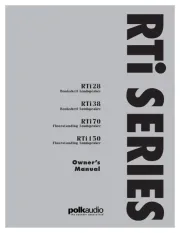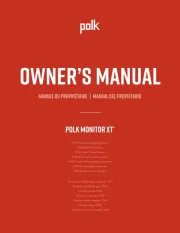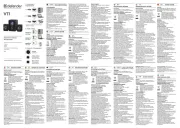Polk MM5251 Handleiding
Bekijk gratis de handleiding van Polk MM5251 (16 pagina’s), behorend tot de categorie Speaker. Deze gids werd als nuttig beoordeeld door 122 mensen en kreeg gemiddeld 3.6 sterren uit 61.5 reviews. Heb je een vraag over Polk MM5251 of wil je andere gebruikers van dit product iets vragen? Stel een vraag
Pagina 1/16

HBP1619-C

3
M o r e I n f o @ w w w . p o l k a u d i o . c o m / c a r
Safe Limits of Operation
Polk Audio specifies the recommended amplification range
for each of its passive (non-amplified) loudspeakers. Typically
that specification will be expressed as a range of power such
as 20-200 W (per channel). It is important to understand
what those numbers mean when choosing a receiver or ampli-
fier for your Polk loudspeakers. The lower number indicates
the lowest continuous rated power that will yield acceptable
performance in a typical listening environment. The higher
number indicates the highest per channel power that should
be used with your Polk speakers. That number should not be
confused with a “Power Handling” specification and it does
not imply that the speaker will safely handle that full amount
of power on a long-term basis. We specify a wide range of
power ratings because not all electronics manufacturers use
the same method for rating power. In fact, high quality lower-
rated amplifiers sound better and play louder than low quality
units with a higher power rating.
Automobile horsepower is a good analogy. Your car probably
has far more horsepower than it needs for your daily commute
and is likely capable of going well over 120mph (190km/hr).
Having that extra power is good for on-ramp acceleration
and danger avoidance (like getting away from brain-eating
zombies) but that doesn’t mean that it is advisable to operate
your car on North American highways at full power and maxi-
mum speed for an extended period of time. Just ask your local
state trooper if you are in doubt. Similarly, we recommend
using amplifiers and receivers with rated power above the
Power Handling limits of our speakers because having extra
power available for short term peaks is conducive to better
sound quality, maximum dynamic range and effortless high
volume output. But we strongly urge you not to use the
full power of your amplifier or receiver for daily listening.
Loudspeakers can be damaged when an amplifier, regardless
of its wattage, is made to play at higher listening levels than
its power can clearly produce. Operation at this level can result
in very high levels of audible distortion originating in the ampli-
fier, which can add a harsh, gritty sound to your listening
material. If you hear distortion—turn the volume down
or risk damaging your speakers. You can damage just
about any speaker, regardless of power rating, if you drive
an amplifier to or beyond the point of distortion.
Bring On The Noize!
Please inspect each loudspeaker carefully. Notify your
Polk Audio dealer if you notice any damage or missing items.
Keep the carton and packing material. They will do the best
job of protecting your speakers if they need to be transported.
Technical Assistance or Service
If, after following the hookup directions, you experience
difficulty, please double-check all wire connections. Should
you isolate the problem to the loudspeaker, contact the
authorized Polk Audio dealer where you made your purchase,
or contact Polk Audio Customer Service 800-377-7655 (M-F,
9-5:30 EST, US only) or via email polkcs@polkaudio.com.
Outside the US, call 410-358-3600.
More detailed information—including audio how-to
articles, FAQs, and online manuals—is available on our
award-winning website: www.polkaudio.com/car.
ENGLISH
2M M : D e s i g n e d T o P e r f o r m
Limites D’Opération
Polk Audio spécifie la gamme de puissance d’amplification
recommandée pour chacun de ses haut-parleurs non amplifiés.
Cette spécification est typiquement exprimée enwatts par
canal(par ex. 20-200 w/Canal). Il est important de bien com-
prendre la signification de ces chiffresavant de choisir
un amplificateur ou un récepteur pour vos haut-parleurs.
Le premier chiffre indique la puissance nominale minimum
requise pour assurer une performance convenable dans une
pièce normale. Le deuxième chiffre indique la puissance
nominale maximum admissible parvos haut-parleurs–ce
chiffre ne doit pas être confondu avec la spécification de
«capacité de puissance» et n’implique pas que le haut parleur
peut soutenir cette puissance de façon continue sans risque
d’endommagement. Nous spécifions une gamme de puis-
sance d’amplification étendue parce que les fabricants
de composants électroniques n’utilisent pas toujours la même
méthode pour déterminer la puissance admissible. En fait, les
amplificateurs moins puissants de qualité supérieure donnent
un meilleur rendement que les amplificateurs plus puissants
de qualité inférieure.
L’automobile et les chevaux-vapeur sont une bonne analogie.
Votre automobile a beaucoup plus de chevaux-vapeur que ceux
requis par son utilisation quotidienne, vous permettant proba-
blement d’atteindre les 190km/h ou plus! Vous ne roulez
pas pour autant à fond la caisse en tout temps (du moins
nous l’espérons.) Cependant, cette réserve de puissance
vous permet de bien accélérer sur les rampes
d’accès, d’éviter les accidents et de doubler sécuritairement.
C’est pour cette même raison que nousvous recommandons
d’utiliser un amplificateur ou un récepteur d’une puissance
nominale plus élevée que la capacité de puissance spécifiée
pour vos haut-parleurs. En effet, cette réserve de puissance
leur permettra de reproduire lescrêtes sonores momentanées
sans effort et sansdistorsion,assurant une gamme dynamique
maximale et une performance optimale, même à très haut vol-
ume. Il est quand même fortement déconseillé d’écouter votre
chaîneaudio«à fondla caisse» entouttemps.
Un haut-parleur peut être endommagé lorsqu’un amplificateur,
quelle que soit sa puissance, est poussé au delà de ses limites.
L'amplificateur surchargé génère alors un niveau élevé de dis-
torsion audible, le son devenant rauque et éraillé. Si vous
entendezde la distorsion, baissezle volume sinon vous risquez
d’endommager vos haut-parleurs. Un haut-parleur, quelle que
soit sa capacité de puissance, risque d’être endommagé
lorsque l’amplificateur est poussé au delà de ses limites
de distorsion.
Guide de démarrage
Inspectez vos haut-parleurs avec soin. Si vous constatez
des dommages ou s’il manque des pièces, contactez votre
reven-deur Polk Audio. Conservez la boîte et l’emballage—
ils assureront la meilleure protection de voshaut-parleurs
en cas de transit éventuel.
Service ou assistance technique
Si, après avoir suivi toutes les instructions, vous éprouvez
des difficultés, vérifiez toutes vos connexions. Si vous en
concluez quele problème estrelié auhaut-parleur, commu-
niquez avec votre revendeur Polk Audio ou contactez le Service
à la Clientèle de Polk Audio au 1-800-377-7655 (L-V, 9-17:30,
HNE, Canada et É.-U. seulement). À l’extérieur des É.-U. et du
Canada, composez le 410-358-3600. Vous pouvez aussi nous
contacter par courriel à l’adresse: polkcs@polkaudio.com.
Pour plus d’information—incluant des chroniques pratiques,
des FAQ et des manuels d’utilisation en ligne, visitez notre
site web primé: www.polkaudio.com/car.
FRANÇAIS

5
M o r e I n f o @ w w w . p o l k a u d i o . c o m / c a r
4M M : D e s i g n e d T o P e r f o r m
Límites Seguros de Operación
Polk Audio especifica el intervalo de amplificación recomenda-
do para sus altavoces pasivos (no amplificados). Por lo general,
la especificación se expresa como un cierto intervalo de poten-
cia, tal como 20 a 200 W (por canal). Es importante entender
lo que estos números significan cuando se escoge un receptor
o un amplificador para los altavoces Polk Audio. El número
inferior indica la potencia nominal continua mínima que
produce un rendimiento aceptable en un ambiente acústico
normal. El número superior indica la potencia máxima por canal
que se debe dar a los altavoces Polk Audio. Este número no
debe confundirse con la “administración de potencia” y no
implica que el altavoz administre indefinidamente con seguri-
dad tal potencia máxima. Especificamos una amplia gama de
valores nominales de potencia porque no todos los fabricantes
de aparatos electrónicos utilizan el mismo método para
establecer el valor nominal de potencia. De hecho, los amplifi-
cadores de alta calidad con valor nominal de potencia bajo
suenan mejor y más fuerte que las unidades de baja calidad
con valor nominal de potencia alto.
La potencia de los automóviles en caballos de fuerza es una
buena analogía. Su automóvil probablemente tiene muchos
más caballos de fuerza de los que necesita para ir diariamente
al trabajo y es capaz de desplazarse a velocidades de más de
120 mph (190 kph). Tener la potencia adicional es bueno para
la aceleración en las rampas de entrada a las autopistas y para
evitar el peligro, pero no significa que sea aconsejable conducir
el automóvil por la carretera a toda velocidad y potencia
durante largos períodos de tiempo. No lo es. Si lo duda, pre-
gúntele a su mecánico local o a la policía. De manera similar,
recomendamos que use amplificadores y receptores con valor
de potencia nominal mayor que los límites de administración
de potencia de nuestros altavoces, porque tener potencia adi-
cional para máximos de poca duración conduce a mejor calidad
de sonido, máxima gama dinámica y salida de alto volumen sin
esfuerzo. Pero le recomendamos enfáticamente que no aplique
a diario a sus altavoces la potencia máxima de su amplificador
o receptor.
Los altavoces se pueden dañar cuando se hace funcionar un
amplificador, independientemente de su potencia en vatios, a
más volumen del que puede producir con claridad. El funcion-
amiento a este volumen puede producir altos niveles de distor-
sión audible originada en el amplificador, lo cual puede agregar
un sonido discordante y arenoso a lo que se está escuchando.
Si oye distorsión, baje el volumen o arriésguese a dañar los
altavoces. Casi cualquier altavoz se puede dañar, independien-
temente de su valor nominal de potencia, si se sube el volumen
del amplificador o el receptor hasta la distorsión y más.
Que Traigan el Zondio
Inspeccione cuidadosamente los altavoces. Comuníquese
con su distribuidor de Polk Audio si falta alguna pieza o si
hay alguna pieza dañada. Guarde la caja de cartón y el
material de empaquetado; son lo mejor para proteger los altav-
oces si hay que transportarlos.
Asistencia o servicio técnico
S i después de seguir las instrucciones de conexión usted sigue
teniendo dificultades, vuelva a comprobar todas las conexiones
de cables. Si logra aislar el problema en el altavoz, comuní-
quese con el distribuidor autorizado de Polk Audio donde
compró el altavoz o con el Servicio al Cliente de Polk Audio
llamando al 800-377-7655 (de lunes a viernes de 9 a.m. a
5:30 p.m., hora estándar del Este, sólo en EE.UU.) o por correo
electrónico a polkcs@polkaudio.com. Fuera de los EE.UU.,
llame al 410-358-3600.
Hay artículos sobre cómo hacer las cosas en audio, preguntas
frecuentes y manuales en línea en nuestro galardonado sitio
Web: www.polkaudio.com/car.
ESPAÑOL
Sichere Betriebsgrenzwerte
Polk Audio legt für jeden seiner passiven (nicht verstärkten)
Lautsprecher einen empfohlenen Verstärkungsbereich fest.
Normalerweise wird dieser Wert als Leistungsbereich ausge-
drückt, wie etwa 20-200 W (pro Kanal). Es ist wichtig, dass
Sie bei der Auswahl eines Receivers oder Verstärkers
für Ihre Polk-Lautsprecher verstehen, was diese Zahlen
bedeuten. Die niedrigere Zahl ist die niedrigste Dauerleistung,
die in einer typischen Hörumgebung einen akzeptablen Sound
bietet. Die höhere Zahl verweist auf die höchste Leistung
(pro Kanal), die mit Ihren Polk-Lautsprechern verwendet wer-
den sollte. Diese Zahl sollte nicht mit der Belastbarkeit ver-
wechselt werden und sagt nicht aus, dass der Lautsprecher
diese Leistung langfristig verkraften kann. Wir geben einen
breiten Belastungsbereich an, da nicht alle Elektronikhersteller
die gleichen Messmethoden verwenden. Hochwertige
Verstärker mit niedriger Belastbarkeit klingen sogar besser und
lauter als minderwertige Verstärker mit hoher Belastbarkeit.
Die PS-Leistung eines Autos wäre ein guter Vergleich. Ihr
Auto hat wahrscheinlich viel mehr PS als für die tägliche Fahrt
zur Arbeit nötig ist und könnte mehr als 190km/h erreichen.
Diese Leistung ist für die Beschleunigung bei der Einfahrt in
die Autobahn und bei der Vermeidung von efahrensituationen
nützlich, aber es ist nicht empfehlenswert, längere Zeit mit
Volltempo zu fahren. Wirklich. Fragen Sie einfach Ihren
Automechaniker, wenn Sie das nicht glauben. Wir empfehlen
analog dazu Verstärker und Receiver mit einer Leistung, die
über der Belastbarkeit unserer Lautsprecher liegt, da die für
kurze Leistungsspitzen verfügbare zusätzliche Leistung eine
bessere Klangqualität, einen maximalen Dynamikbereich und
eine mühelose Wiedergabe hoher Lautstärken ermöglicht.
Aber Sie sollten auf keinen Fall die volle Leistung Ihres
Verstärkers oder Receivers für den Dauerbetrieb verwenden.
Wenn ein Verstärker, ungeachtet seiner Leistung in Watt,
lautere Musik abspielt, als er ohne Verzerrung produzieren
kann, kann dies die Lautsprecher beschädigen. Bei einem
Betrieb mit dieser Lautstärke kann der Verstärker sehr hohe,
hörbare Verzerrungen erzeugen, welche die Musik rau und
grob klingen lassen können. Wenn Sie Verzerrungen hören,
sollten Sie die Lautstärke reduzieren, damit Ihre Lautsprecher
nicht beschädigt werden. Sie können praktisch jeden
Lautsprecher (ungeachtet der Belastbarkeit) beschädigen,
wenn Sie einen Verstärker bis zu dem Punkt aufdrehen,
wo Verzerrungen eintreten, oder noch darüber.
Erste Schritte
Inspizieren Sie bitte jeden Lautsprecher sorgfältig.
Verständigen Sie Ihren Polk Audio-Fachhändler, falls Sie
Schäden oder fehlende Teile bemerken. Bewahren Sie den
Karton und das Verpackungsmaterial auf. Diese schützen bei
einem etwaig nötigen Versand die Lautsprecher am besten.
Technischer Kundendienst und Service
Wenn Sie Probleme haben, nachdem Sie den Installationsan-
weisungen gefolgt sind, sollten Sie alle Kabelverbindungen
nochmals prüfen. Wenn Sie zu dem Schluss kommen, dass
das Problem am Lautsprecher liegt, kontak-tieren Sie bitte den
autorisierten Polk Audio-Händler, bei dem Sie den Lautsprecher
gekauft haben, oder rufen den Polk Audio-Kundendienst unter
800-377-7655 (M-F, 9-17:30 Uhr US-Ostküstenzeit, nur USA)
an oder senden eine E-Mail an polkcs@polkaudio.com.
Von außerhalb der USA rufen Sie +1 410-358-3600 an.
Detaillierte Anweisungen, Antworten auf häufig gestellte
Fragen und Online-Handbücher finden Sie auf der preisgekrön-
ten Website: www.polkaudio.com/car.
DEUTSCH
Product specificaties
| Merk: | Polk |
| Categorie: | Speaker |
| Model: | MM5251 |
Heb je hulp nodig?
Als je hulp nodig hebt met Polk MM5251 stel dan hieronder een vraag en andere gebruikers zullen je antwoorden
Handleiding Speaker Polk

6 Juni 2025

3 Juni 2025

7 Mei 2025

14 Januari 2025

15 November 2024

18 Augustus 2024

13 November 2023

20 Juli 2023

13 Juni 2023

11 Juni 2023
Handleiding Speaker
- Visaton
- Thiel
- EarFun
- Klipsch
- WyreStorm
- Amina
- Astell&Kern
- Homedics
- Phonic
- Ibiza Sound
- Sogo
- TWF
- Bopita
- Krüger And Matz
- Tema
Nieuwste handleidingen voor Speaker

16 September 2025

16 September 2025

16 September 2025

15 September 2025

15 September 2025

15 September 2025

15 September 2025

15 September 2025

15 September 2025

15 September 2025